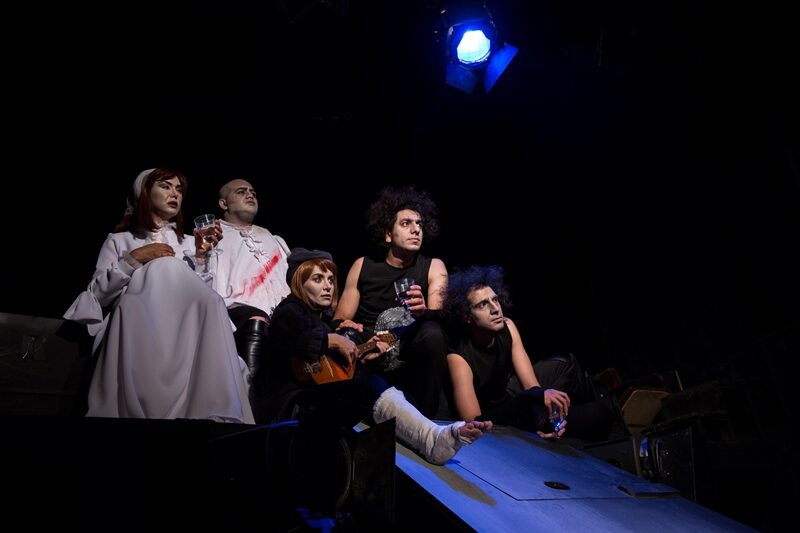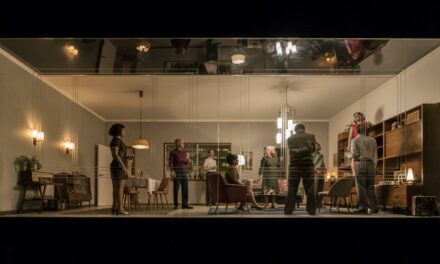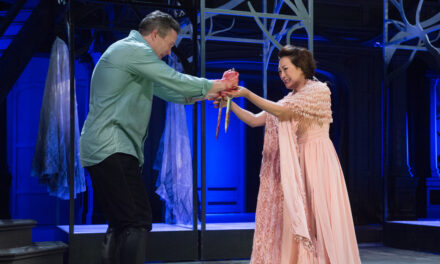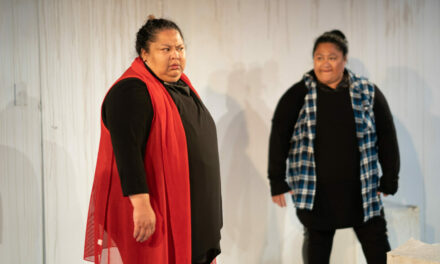Read Farinaz Kavianifar’s interview with Rūhollah J’afari.
On the evening of August 3, 2018, I recall most lucidly the numerous riot police gathered outside Tehran’s City Theatre on Enghelāb Street (one of the most populated streets of Tehran). My plan to attend Rūhollah J’afari’s Richard III Will Not Take Place occurred at the peak of economic and civil outbreaks that were occurring in Iran. As I entered Chāhārsoo Hall, I envisioned that I would be entering a different atmosphere, but it appeared that the play was not far from the real-life events stirring outside the doors of the venue. Rūhollah J’afari is perhaps one of the boldest venturers in the field of theatre in Iran. As a director and dramaturg, he not only strives to transcend selected texts but also breaks boundaries and restrictions pertaining to his work. J’afari’s most recent production – in addition to his own unique dramaturgy – was a showcase of the French-Romanian playwright Matei Vișniec’s Richard III Will Not Take Place. The play was performed in Tehran’s City Theatre’s Chāhārsoo Hall in
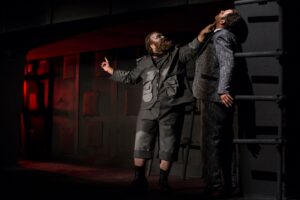
Hamid Rahimi and Pouria Soltanzādeh. Photo by Fahimeh Hekmatandish
July and August of 2018. On average, plays are performed for thirty days, yet J’afari’s Richard III Will Not Take Place was unexpectedly suspended on the twenty-sixth night by the operating chief of Tehran’s City Theatre. Needless to say, J’afari’s production was favored by audiences and received widespread coverage from state and private media outlets.
Richard III Will Not Take Place features the Russian theatre director Vsevolod Meyerhold (1874–1940). Meyerhold strives to obtain a permit to stage Shakespeare’s Richard III but faces problems with the visions he aims to manifest. The play is set during the critical 20th-century Russia, a period in which citizens sought independence from the Soviet Union. Throughout Meyerhold’s directing, members of the commission eavesdrop and observe Meyerhold’s every step. The commission members view Meyerhold’s work as dangerous and believe that certain features of the play require omission. Meyerhold constantly battles with his own artistic desires and that of the commission’s, as even the most mundane accessories are cleansed of ideological attachments and actors are prohibited from making eye contact with the audience for prolonged periods or from maintaining a durable silence onstage. The play occurs in a hazy atmosphere, an isthmus in which Meyerhold is half-awake. Dialogues and characters who appear onstage walk the fine line of being a part of Meyerhold’s mere imagination. Ultimately, Vișniec is demonstrating the lack of artistic agency and freedom of speech and individuality.
Interestingly enough, the audience was completely absorbed into this particular atmosphere during J’afari’s play. Dialogues about individual and societal freedom and censorship drew scrupulous attention. J’afari’s version of the production also lacked satirical themes, which are portrayed in the French productions of the play; where the French audience would roar in laughter, Iranians showed blank visages and stiff bodies. Matters of self-censorship and artistic freedom may be long past for France, but the issues raised in Vișniec’s work are ones that are addressed daily on an artistic and individual level in Iran. Audience reactions were also a reciprocal reflection of and even meditation on the political and economic outbreaks outside the black-box stage. J’afari’s play was a continuation of the outcries and occurrences of the streets of Tehran, Shiraz, Esfahan and other major cities. J’afari states that “art should not be imprisoned between any four walls, because the description of art in itself is boundary breaking. Art is a mental, spiritual, and social need that aims to reflect the society . . . The play Richard III Will Not Take Place also attends to such matters.”[1] With his attentive care, a play was selected that portrayed an incident in the past, 20th-century Russia, that also falls perfectly within the timeline of contemporary Iran.
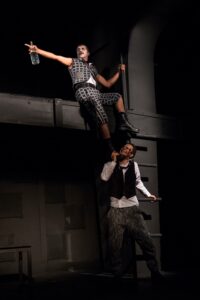
Hamid Rahimi (down) and Majid Rahmati (up), photo by Fahimeh Hekmatandish
The play resembles a mirror image of J’afari alongside Meyerhold and Vișniec. J’afari can be seen in parallel with both figures. His personal attachment to Vișniec’s plays tells of his own ideologies and beliefs. In fact, the reoccurrence of the directing and dramaturgy of Vișniec’s works could be J’afari’s own unique path to identity and philosophical inquiry. By imposing Vișniec’s universal themes onstage, J’afari is exposing his outlook on politics and society. In addition, the directing of a non-fictitious character, Meyerhold, in scenarios of temptation and difficulty (the commission’s inspection) resembles events that J’afari has personally faced during his career in theatre. With that said, Richard III Will Not Take Place is a reoccurrence of history not only at a geographic level (Russia and Iran) but also at an individual level (Meyerhold and J’afari). In this manner, it appears that J’afari might have even gone back in time and seen again the struggles and countless inquiries and accusations that might have been directed at his performances. Additionally, despite the hardship, Meyerhold does not allow the voices of censorship to intrude and invade his being, which is a principle quite visible in J’afari’s narrative.
On a larger scale, this play is most definitely a tale once told and experienced for others living and participating not only in theatre but in Iran’s general art world. Thus, as mentioned above, this play embeds a historical tale that has been repeating both in the past and in different forms in the present. It is no coincidence that Vișniec incorporates the Shakespearean play Richard III, which narrates the tale of a Machiavellian struggle and revenge, alongside a Meyerhold in a 20th-century Russia. The same principle applies to J’afari, who demonstrates this framework in relation to a 21st-century Iran; J’afari is portraying a vicious cycle of historical continuation and conquest. The conquest applies not only to political but also to societal and individual spheres. Thus, until the human race has wiped itself clean of the blood of power and the sacrifices needed to attain carnal desires, ‘Richard III Will Not Take Place’.
Coincidentally, as J’afari’s Richard III Will Not Take Place was in production, Shakespeare’s Richard was taking place at Vahdat Hall, June to September of 2018, directed by Ḥamīdrezā Na’īmī .[2] It was an interesting parallel, as Na’īmī’s production focused on the Machiavellian features of Richard and the power-thirsty entity, or the living ‘Richard’, that has the ability to manifest in any individual. As J’afari’s work provided a contemporary outlook on both Shakespeare’s account and Vișniec’s story, Na’īmī delivered a historical tale that could be observed as a useful margin not only to J’afari’s play but to Iran’s society at large. On an artistic scale, the commerciality of Na’īmī’s production exceeded that of J’afari’s. The mere fact that Na’īmī’s play exceeded the average one-month performance demonstrates the commerciality of the production. Na’īmī cast famous stars of cinema, whereas J’afari’s actors were not of big names. Na’īmī also cultivated a bourgeois scenery of glamour; J’afari’s scene was plain and minimal. Overall, as Na’īmī strived to create visual satisfaction, J’afari aimed for mental stimulation.
Vișniec’s Richard III Will Not Take Place was also performed by Asghar Nourī[3] from December 2016 to January 2017, yet Nourī and J’afari’s productions vary in scale. For one, Nourī’s play lacked a scenic design and utilized a few chairs and tables, along with a bed and a suspended window in the background. In contrast to this, J’afari’s scenic design was minimal enough to follow Meyerhold’s principles of biomechanics but delivered a lavish artistic visual in the midst of simplicity. For instance, J’afari restructured the entire stage in a way that had not been utilized since Iran’s 1979 Revolution. He expanded the stage in both width and height, as he added multiple floors and points of entry and exit for actors, and, as Ehsān Zīvar’Ālam[4] describes in Etemād Newspaper, “a theatre stage that resembles more of a catwalk . . . that allows actors to ascend and descend the stage in all directions.”[5] Throughout the play, various actors approach Meyerhold in order to convince him of and deceive him about abandoning his ideology, only to side with those of the state. In Zīvar’Ālam’s belief, the catwalk technique adequately portrays the various intrusions on Meyerhold by other characters onstage. In another article, ‘Alīreżā Narāghī[6] states, “In the same way that the chambers of Meyerhold’s thought are reflected in the balconies of Chāhārsoo Theatre, the elements of censorship are also visible [in the same corridors]”.[7] J’afari surpasses the mere scripted lines and embodies the element of censorship present in Vișniec’s text even upon the walls and corridors of the set.
The original scene design at Chāhārsoo Hall provided a novel experience for audience members, and, as J’afari stated, “the audience had to continuously turn their heads from left to right so that they would not miss any occurrences. For instance, in the opening acts of the play, the audience faces an event that happens at the far right of the stage and an event that occurs at the far left simultaneously. This movement done by the audience is in itself biomechanics.”[8] J’afari eagerly embraces new forms and structures in his work. For instance, there was a two-minute period of pure darkness onstage which, according to J’afari, was the first time that such an event was experienced in Iranian theatre. He states that not a word was uttered in these two minutes, and that “it allowed the audience to face complete silence . . . which in fact is none other than censorship.”[9] In one scene of the play, “words are dangerous” and “pauses carry an ulterior motive” and are uttered by the commission members, which results in the self-censorship of Meyerhold and that of the actors. The play demonstrated the disappearance not only of theatre as an art form but also that of words, meaning, free will and identity. With that said, the directed darkness and silence in J’afari’s dramaturgy reversed roles and asked the audience to participate in the events and inquiries present onstage.
J’afari is a strong believer that “art is not merely for the sake of art”,[10] and that alongside its role for entertainment, art should serve as a cultural and educational vessel. He states, “In all these years, I’ve tried to maintain my productions based on a three-sided pyramid: instruction, research, and observation of other works of theatre. Paying attention to these three aspects allows the opportunity to be at one with my people and not separate from them. I share the same worries and questions as other citizens. This is how I can take a production on stage that can make direct contact with the audience.”[11] Rūhollah J’afari strives to deliver productions that maintain the correct and necessary criteria for a work of art. As he brought contemporary incidents of Iran onto the stage in his Richard III Will Not Take Place, he engaged the audience and left them to further reflect and inquire upon the curtain calls. For instance, on the theatre sales platform website Tiwall, many comments[12] were left about J’afari’s play. One individual wrote, “the extraordinary play (and performance) about those who have swords to destroy ideology, especially when the spades are under the hands of the rulers . . . and how coordinate was this play with the atmosphere of our own society.”[13] Another individual favored Meyerhold’s lines and praised J’afari’s costume design, lighting and set and, in conclusion, stated, “I hope the sharp swords do not strike your thought and pen”.[14] The audience’s reception generally reflected their view of the play as a reciprocation of their own day in Iran. One commenter stated, “An extremely interesting text from Visniec, demonstrating our current day. An honest yet blood-thirsty Richard in opposition to the rulers, who are wolves in clothes of sheep. I believe that this play was selected and performed at a timely fashion.”[15] An Iranian American professor, Pardis Minuchehr, who also saw the play, shared similar thoughts: “J’afari had directed the short Romanian play in the small Chāhārsoo theatre of the City Theater – just at the historical time when his audience needed to cross the full geared uniformed officials in order to enter the theater. Uncannily, the play set in the former Soviet bloc seemed to be illustrating the kind of state intervention writers and artists confronted in modern day Iran. For the Iranian audience, the state intervention evoked something that was not foreign to them at all, and in fact, with the presence of riot police, it was very immediate. The professional set inside and the precarious conditions outside contributed greatly to the aesthetics of fear, a politics to incite fear for those who dare to express themselves beyond the perimeters ascribed to them.” Thus, whether one is an Iranian citizen or a traveler, there is a clear mutuality between the responses and feelings that this play evoked amongst the audience. In conclusion, J’afari’s Richard III Will Not Take Place successfully gathered men – Vișniec, Meyerhold, Richard III – from different geographic locations and placed them on Chāhārsoo’s stage as links of continuation and reflection for modern Iran.
Notes
[1] Sabā Heydarkhānī, “Report from the Practices of the Play Richard III Will Not Take Place,” Kār Īrān, 2018.
[2] Ḥamīdrezā Na’īmī (b. 1974) is an Iranian playwright and theatre director.
[3] Asghar Nourī (b. 1976) is a translator of dramatic texts. He also has a master’s degree in Theatre Directing.
[4] Ehsān Zīvar’Ālam is an Iranian journalist, translator, and art critic. He writes for Tasnim News, Etemad Newspaper, and other media outlets in Iran.
[5] Ehsān Zīvar’Ālam, “A Promising Play, a Professional Play,” Etemād Newspaper, 2018, www.tiwall.com/news/richard-ejranemishavad2-note4?print=1.
[6] ‘Alīreżā Narāghī is an Iranian theatre director and journalist.
[7] Alīreżā Narāghī, “Revolution against a Revolutionary,” Drāmā Naghd, Aug. 2018, dramanaghd.ir/4561/.
[8] Shaghāyegh Fereshteh, “Rūhollah J‘afarī Believes That ‘Art for Art’ Can Not Be a Roadmap to a Brighter Tomorrow,” Honar Online, 2018, www.honaronline.ir/122847.
[9] Ibid.
[10] Ibid.
[11] Ibid.
[12] The authors of these posts will remain anonymous in order to observe their privacy.
[13] https://www.tiwall.com/p/richard-ejranemishavad2
[14] Ibid.
[15] Ibid.
This post was written by the author in their personal capacity.The opinions expressed in this article are the author’s own and do not reflect the view of The Theatre Times, their staff or collaborators.
This post was written by Farinaz Kavianifar.
The views expressed here belong to the author and do not necessarily reflect our views and opinions.

